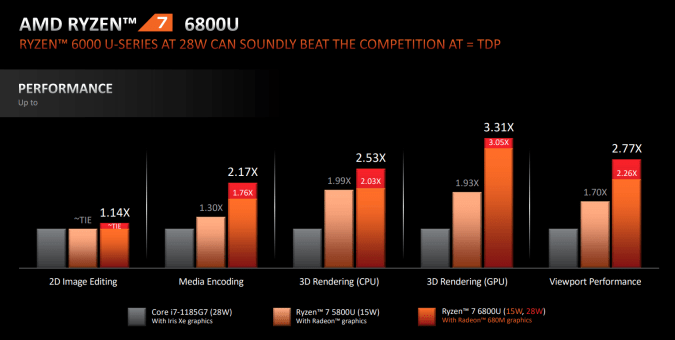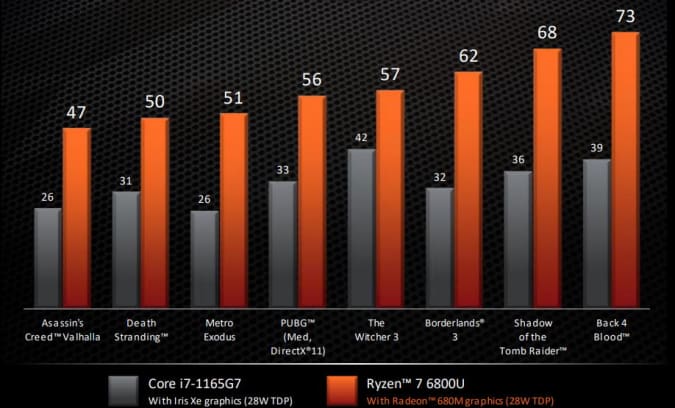
It's clear that AMD is taking some big swings with its new Ryzen 6000 mobile chips. At CES, the company announced that they would sport integrated RDNA2 graphics for the first time, offering enough power to play modern games in 1080p. But while AMD was quick to show off its top-end model, the Ryzen 9 6980HX, it had little to say about its U-series hardware for ultraportables. It turns out, the chip giant was saving some of the most intriguing details for last.
While more graphics power is certainly nice to have, courtesy of its new Radeon 680M integrated GPU, AMD is emphasizing efficiency above all with the Ryzen 6000 line. Improvements in its Zen 3+ core, power management and its 6nm process led AMD to make some bold claims during a recent briefing with media. For one, AMD says it was able to push base clock speeds up around 40 percent in its 15-watt U-series parts. That led to a 17 percent increase in performance over the previous generation, as well as an 81 percent jump in graphics speeds and an additional 3 hours of battery life. Not bad for a company that, just a few years ago, had no presence in the ultraportable market.

To drive the efficiency point home, AMD says that its 15-watt U-series chips can practically obliterate Intel's 11th-gen 28-watt hardware. The company's testing shows that the new Ryzen 7 6800U is around 24 percent faster than the Core i7-11857G. Of course, we always have to take internal benchmarks with a grain of salt. And it's worth noting that AMD didn't have access to Intel's 12th-gen hardware, which promises to be vastly superior to the 11th-gen thanks to their hybrid core model.
AMD boasts that it's offering full-powered cores across the board with the Ryzen 6000 line, whereas Intel has to split things up between powerful P-cores and efficient (and archaic) E-cores. And there's no doubt that the Radeon 680M is also going to be a compelling feature for mainstream gamers. AMD says its Ryzen 5 6600U can reach up to 128 fps in Age of Empires 4, compared to the 86fps Intel's Irix Xe graphics reached on the i7-1135G7. The difference is more pronounced among more demanding titles: AMD's graphics hit 52 fps in Shadow of the Tomb Raider, while Intel's only reached 32fps. (The company notes that you may have to use low graphics settings to see similar scores in some games.)

With performance like that, it may make more sense for cash-strapped PC shoppers to just rely on integrated graphics, rather than shelling out hundreds more for a system with a cheap dedicated GPU. The Radeon 680M, which is built into the new Ryzen 7 and 9 chips, offers up to 12 compute cores that can reach 2.4GHz. The lower-tier Radeon 660M graphics on the Ryzen 5 halves that compute core figure, and reaches up to 1.9GHz.
Here's the thing, though: Both Intel and AMD will breathlessly claim their new chips are better than their competitor's last-gen hardware. Neither company was able to pit their freshest wares against each other. So as compelling as the Ryzen 6000 mobile chips sound now, it'll be interesting to see how they stack up to Intel's 12th-gen hybrid chips once we can get some independent head-to-head comparisons. For now, though, it seems like an AMD ultraportable may be just what some consumers are looking for.
